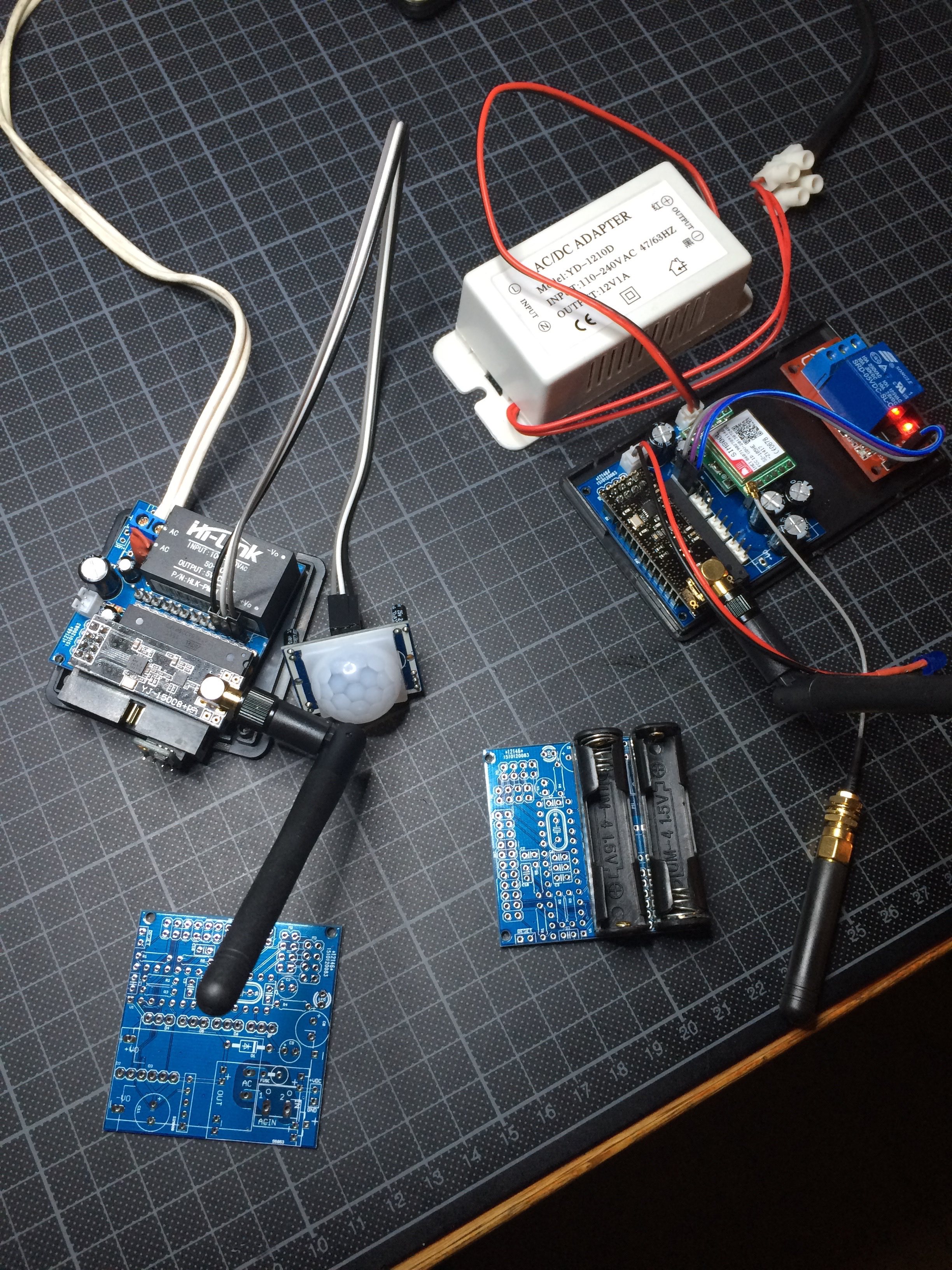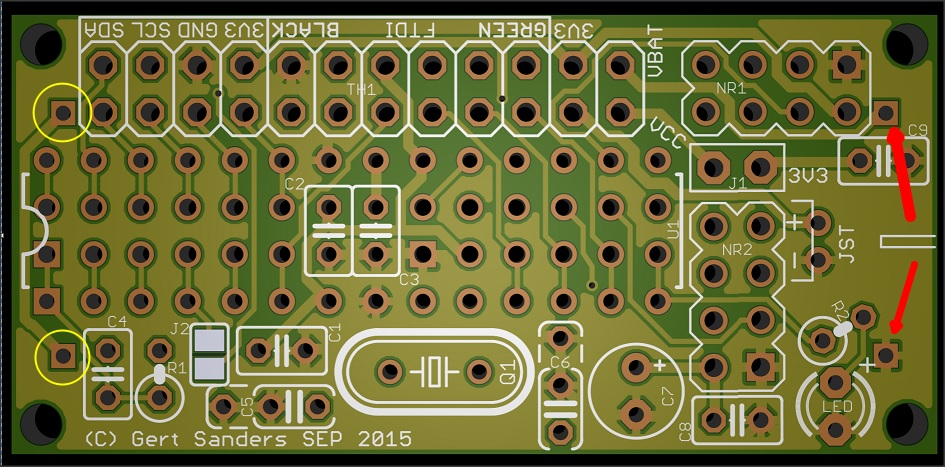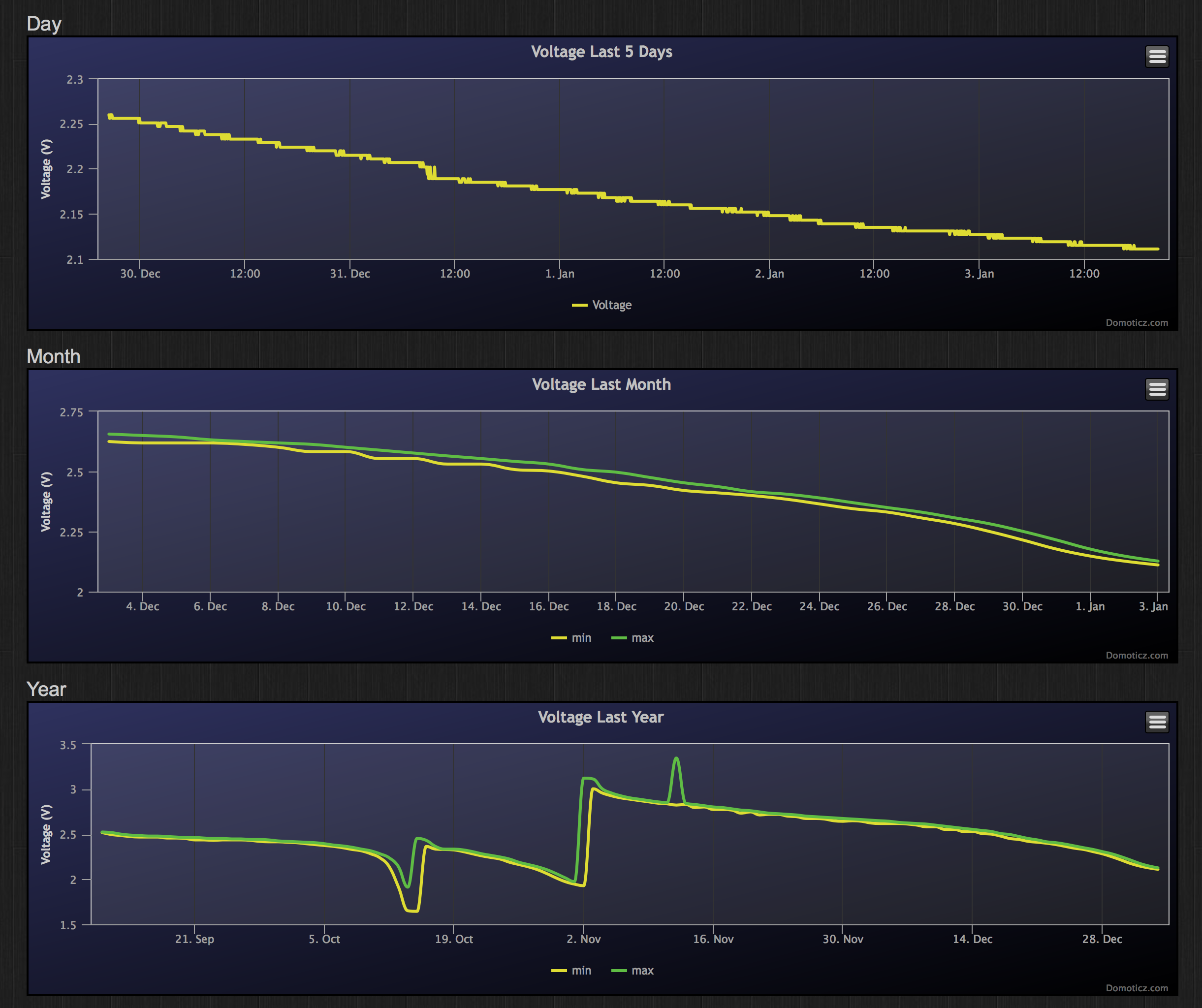My own board (50mm x 30mm)
-
@GertSanders
Do you have a source or shop for the AAA battery holder with solder pins? I did only find some for AA batteries. -
@alexsh1 It is based on my AC capable board, is a normal atmega328p board, but with a SIM800L mounted on it. This module allows me to send and receive SMS's, and I use one of the digital output pins to control a waterpump. I have a second AC based board ready which will be my MySensors SMS gateway. This means it will be able to receive V_TEXT and send that to the default GSM number as a SMS. It should be possible to receive SMS and send that as V_TEXT to other nodes, but so far I have not started the design of the second sketch yet.

You see it here also (top right) with the relay module and the white AC-DC converter connected.

Side view:

@GertSanders said:
@alexsh1 It is based on my AC capable board, is a normal atmega328p board, but with a SIM800L mounted on it. This module allows me to send and receive SMS's, and I use one of the digital output pins to control a waterpump. I have a second AC based board ready which will be my MySensors SMS gateway. This means it will be able to receive V_TEXT and send that to the default GSM number as a SMS. It should be possible to receive SMS and send that as V_TEXT to other nodes, but so far I have not started the design of the second sketch yet.
I only have 1-2 high current (3kWh at 240V resistive load) devices at home and I am already controlling them as well my internet router (remote reboot if no internet) via SMS. At this stage I need a larger property to expand my home automation lol :satisfied: :satisfied: :satisfied:
-
@GertSanders
Do you have a source or shop for the AAA battery holder with solder pins? I did only find some for AA batteries.@gloob said:
@GertSanders
Do you have a source or shop for the AAA battery holder with solder pins? I did only find some for AA batteries.Would you mind me asking why you'd need AAA batteries? Much less capacity and the holder is not much smaller. I have been using Eneloop AA rechargable lithium batteries (http://www.ebay.co.uk/itm/4pcs-1-5V-AA-2200mWh-Lithium-li-ion-Rechargeble-Battery-4-PORTS-AA-charger-/272027421169?hash=item3f561909f1:g:r9AAAOSwMTZWSFHz) and they are holding up really well. The advantage is that they hold 1.5V almost until they are discharged unlike NiMh
-
@gloob I got my AAA holders from Aliexpress.
-
-
Indeed, those :+1:
-
@gloob Not yet, some of mine have been running for 2months with a voltage drop of less then 1%
-
@gloob There are two connections on the board to allow soldering the battery holder. Both the AA and AAA versions I use have the same pin spacing (seems standard), so you can use an AA battery holder as @alexsh1 does, or an AAA as I have.
http://forum.mysensors.org/uploads/files/1446751714416-image.jpeg
The red arrows show where the batteryholder pins should go. If you have individual AAA battery holders, then the pins surrounded by yellow circle are also used to connect the batteries in series. If the battery holder holds 2 batteries, then only the pins pointed to by red arrows are used.

The PLUS sign next the the pin on the lower right of the above image is for the LED, the polarity of the pins from the battery is marked on the silkscreen of the bottom side. Looking at it from the top side, the pin above right is for Positive, the pin on below right is for Negative (or GND).
Jumper J2 is to connect the IRQ pin from the NRF24 to pin 2 (INT0) of the atmega328. You could also use that to connect a switch between the top jumper pad (connected to pin 2) and the extra ground pin of C5, to use with a doorswitch. I have used this with the internal pull up, but that would not be very good for the battery-use. It is better to use a 1MOhm pull up resistor wich can also be connected using the extra hole connected to pin 2 and Vcc
-
@alexsh1 I completely switched off the BoD in my fuse settings, this saves the battery even more. I found that the processor kept working down to around 1,64V. Even my NRF24 worked to that low level, because the last message I received in my Domoticz from that node gave a battery voltage of 1.64V
Anyway, since I monitor all battery levels via a script in Domoticz, there is no need for BoD.@GertSanders said:
@alexsh1 I completely switched off the BoD in my fuse settings, this saves the battery even more. I found that the processor kept working down to around 1,64V. Even my NRF24 worked to that low level, because the last message I received in my Domoticz from that node gave a battery voltage of 1.64V
Anyway, since I monitor all battery levels via a script in Domoticz, there is no need for BoD.How is 1.64v possible,It was my understanding that 8Mhz requires a minimum of 2.4v?
-
@rmtucker The firmware itself does not need to be changed to use the internal oscillator. You accomplish that by using a different set of fuse values:
atmega328pO4M8i.bootloader.low_fuses=0xE2
atmega328pO4M8i.bootloader.high_fuses=0xDE
atmega328pO4M8i.bootloader.extended_fuses=0x07This sets the processor to a mode using the internal oscillator.
Add the call to divide the frequency by 8 (can be done in the sketch itself) and you have a 1MHz internal clock.
-
@rmtucker The firmware itself does not need to be changed to use the internal oscillator. You accomplish that by using a different set of fuse values:
atmega328pO4M8i.bootloader.low_fuses=0xE2
atmega328pO4M8i.bootloader.high_fuses=0xDE
atmega328pO4M8i.bootloader.extended_fuses=0x07This sets the processor to a mode using the internal oscillator.
Add the call to divide the frequency by 8 (can be done in the sketch itself) and you have a 1MHz internal clock.
@GertSanders So have you never found it a problem running at 8Mhz?
Do most of your sensors work ok below the 2.4v threshold?
Guess i will find out when the pcb boards arrive:smiley: -
@rmtucker Short answer: yes. So far most my sensors are working fine and all sit above 2.4V but I have not had problems when they do below 2.4V
There is one sensor now that has a battery in decline. This sensor uses a lot of power and goes through it's batteries very fast. So it is a good test for this low voltage work. It is now at 2.11V and still sends messages every 5 minutes. On the first graph you can see it is still working fine wel below 2.4V and it is clocked at 8MHz with a crystal.

I have a notification on all my sensors so that when the battery voltage goes below 2V I get a Prowl from Domoticz. This has only happened on this sensor (twice so far), because I was using NiMH batteries (which discharge faster than alkaline). Around 2 november I put in 2 alkaline batteries (AAA), but these were not brand new.
Most of my sensors have a discharge pattern as here below:

-
@rmtucker Short answer: yes. So far most my sensors are working fine and all sit above 2.4V but I have not had problems when they do below 2.4V
There is one sensor now that has a battery in decline. This sensor uses a lot of power and goes through it's batteries very fast. So it is a good test for this low voltage work. It is now at 2.11V and still sends messages every 5 minutes. On the first graph you can see it is still working fine wel below 2.4V and it is clocked at 8MHz with a crystal.

I have a notification on all my sensors so that when the battery voltage goes below 2V I get a Prowl from Domoticz. This has only happened on this sensor (twice so far), because I was using NiMH batteries (which discharge faster than alkaline). Around 2 november I put in 2 alkaline batteries (AAA), but these were not brand new.
Most of my sensors have a discharge pattern as here below:

@GertSanders What rate is the sensor in the very bottom graph sending messages?
That discharge rate looks very nice.@GertSanders said:
@rmtucker The firmware itself does not need to be changed to use the internal oscillator. You accomplish that by using a different set of fuse values:
atmega328pO4M8i.bootloader.low_fuses=0xE2
atmega328pO4M8i.bootloader.high_fuses=0xDE
atmega328pO4M8i.bootloader.extended_fuses=0x07This sets the processor to a mode using the internal oscillator.
Add the call to divide the frequency by 8 (can be done in the sketch itself) and you have a 1MHz internal clock.
Problem with using div/8 in the sketch and not altering the bootloader is that all the timings are off for baud rates and pwm etc.
Where if it is altered in the bootloader it all works as it should.Last question i promise :yum:
I currently use the arduino mini pro and when uploading sketches to it using ftdi,i have to press the reset button to get the upload to work.
Will i have the same problem with your boards?

